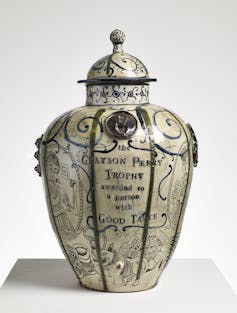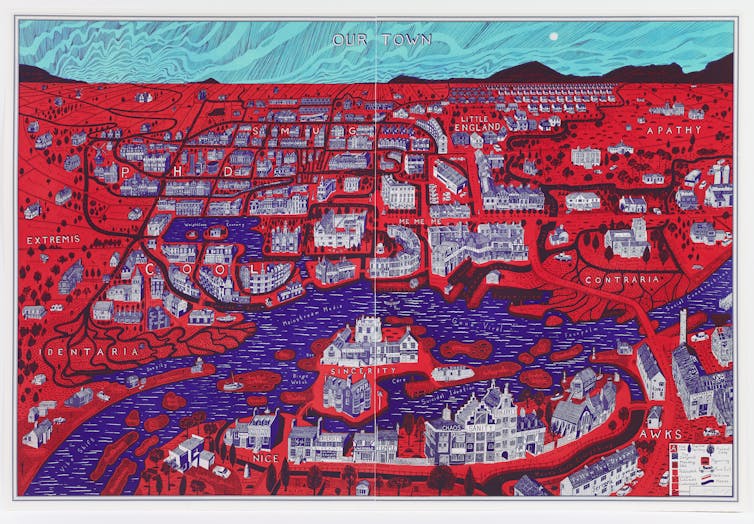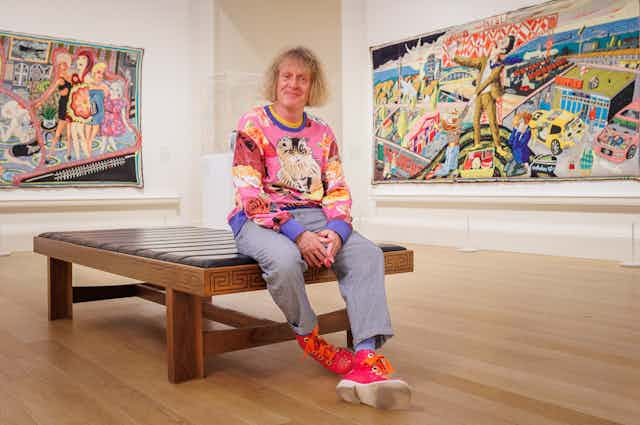Smash Hits, the new Grayson Perry retrospective at Edinburgh’s National Galleries, spans the 40-year career of the recently knighted artist. It’s an exhibition packed with scrutiny of the entanglements of self and society, as Perry casts up snippets of the institutional landscapes that formed him: family, England, the art world.

Perry’s artistic journey began with evening classes in pottery. His Kinky Sex plate (1983) shares the chunkiness of his recent ceramic English Wanker (2023). This makes a satisfying contrast with the highly polished style of his vases and the intricacy of his prints and tapestries.
Everything is beautifully made. Perry operates in a realm serviced by elite fabricators, while the exhibition text notes that all his pots are made with the coil method (one of the oldest techniques used to make pots): “Perry has never used a pottery wheel.”
The social mobility central to Perry’s life and to which he often refers (see 2015’s A Perfect Match – the Life of Julie Cope) has collapsed in the UK since the artist’s rise from 1980s working-class upstart to art-world darling 40 years later.
Access to adult education, arts funding and affordable housing – some of the conditions that helped make Perry – have all been eroded. It is hard to imagine the young artist of Sales Pitch (1987) growing up on a council estate and achieving such success now.
Sympathetic heretic
For all his astonishing success, Perry is likeable because he casts a critical eye on himself as much as others. His brand of self-mocking “iconclasm” is on parade in the print Map of Nowhere (2008). This depicts Perry “as a God … A heavenly light shines out of my anus onto a mountaintop shrine”. For a clue on how seriously we should take this divinity, Perry adds: “Doubt [is] the essence of civilisation.”
A mixed-class couple I chatted to in front of one of six engrossing tapestries in the series The Vanity of Small Differences (2012), described Perry as “cutting but kind, judgy but not”. This carefully crafted role embodies Perry’s attention to the complexity and contradictions of being human. These lie at the heart of his work and are named in his discussion of his transformation through therapy.
The couple recognised themselves in the signifiers of class, status and aspiration in which the artist deals: Aga, Le Creuset, Penguin mugs. A jar of jam labelled “Allotment organic homemade local” sums up the way that food, along with clothes, furnishings and behaviour, crystallise class structures.
Across seven galleries that present a chronological medley of his life’s work, Perry is often right on the money with his stock-in-trade deconstructing and remixing of the foibles, hypocrisies and contradictions that lurk within institutions and psyches.

His success is encapsulated in the trajectory from Early English Motorcycle Helmet (1981) – his mash-up of Anglo-Saxon relic and his obsession with motorcycles – and the triumphantly garish Kenilworth AM1 (2015), Perry’s two-wheeled “popemobile” and performance-art prop.
Kitsch, elegance and laughs mix with pathos and irreverence. This emotional palette contrasts with the virtue signalling he calls out in the colour woodcut Selfie with Political Causes (2018) or his comment on “the puritanism of woke culture”. The sight of Perry’s iconic Claire’s Coming out Dress (2000) lit spectrally in an alcove feels earnest and playful. It is moving to read Perry learn that:
Being a transvestite wasn’t about pretending to be a woman. It was about me putting on the clothes that gave me the feelings that I wanted.
Made in Britain
The retrospective focuses on English tropes and travails and the homogenising force of “Britishness”. One exception is Two Old Guys Wearing Check Skirts (2023) a ceramic showing “Alan [Measles] in his Tam O'Shanter cap and kilt and Claire in Balmoral drag”, with Perry noting that, “Scotland suffers from tourist clichés as much if not more so than England”.
Another is the embroidery Britain is Best (2014) which depicts five men crammed on one horse, based on interviews with Unionists in Northern Ireland for his television series Who are You?. “They seem to be holding out for an imagined Golden Age,” Perry muses.
His retrospective comes in a year of strikes that echo the mass uprisings of the 1980s, and it is clear Perry is interested in workers. The large ship sculpture The Tomb of the Unknown Craftsman (2011) considers the fact that “a minority of the millions of artefacts in the [British] museum had makers attached to them”. In Death of a Working Hero (2016), Perry reflects on the annual Durham Miners Gala, which celebrates the vibrancy of “community, international solidarity and working-class culture ” today.

In Edinburgh, a city that epitomises privilege and the extremes of uneven wealth, Perry’s show follows the group exhibition Poor Things at the nearby Fruitmarket Gallery. Reflecting practices shaped by diverse working and lower-middle class backgrounds, the artists shared Perry’s view that art can be powerful and funny.
But their show’s insightful closing talk offered a starker exposé of how the brutality of the class system limits opportunities in life, including the arts. Some critiqued art world expectations that working-class art be defined by hardship, which their playful artworks and the humour and excess of Perry’s art defy.
Imagination, depicted as a river in Perry’s wonderful A Map of Days (2013) uproots oppressive states, inner and outer. It is common to us all, but our ability to exercise it is linked to our basic material security and the opportunity to have the time, the freedom and the means to live a full life: key demands of strikers. The absence of these conditions cuts us off from fulfilling our potential; it alienates us.
Smash Hits epitomises Perry’s journey from alienation to self-fulfillment. It shares captivating art and hard-won lessons about life. But to understand how the many might join him and thrive, rather than merely survive, we must look beyond the maps that Perry provides.

